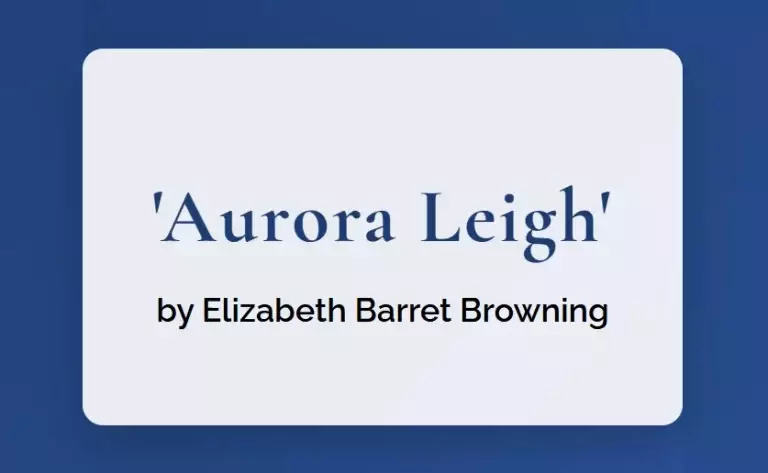An exploration of Elizabeth Barrett Browning’s groundbreaking Aurora Leigh that merged the novel form with epic poetry, creating a masterpiece of feminist literature that resonates across centuries.
Introduction: A Revolutionary Work
Elizabeth Barrett Browning’s “Aurora Leigh” (1856) opens with an assertive declaration of poetic purpose:
“Of writing many books there is no end; And I who have written much in prose and verse For others’ uses, will write now for mine,— Will write my story for my better self”
These lines immediately establish the work’s dual nature as both autobiography and artistic manifesto, setting the stage for what would become the Victorian era’s most ambitious verse novel.
Form and Innovation
Aurora Leigh Structure
Barrett Browning’s mastery of form is evident in her seamless blend of narrative and poetry. Consider this passage describing Aurora’s early reading:
“I read much. What my father taught before
From many a volume, Love re-emphasized
Upon the self-same pages:
Theophrast Grew tender with the memory of his eyes,
And Ælian made mine wet.”
The author uses blank verse throughout, but varies the rhythm to create both intimate personal moments and sweeping social commentary.
Feminist Themes and Social Commentary
The Woman Artist’s Struggle in Aurora Leigh
One of the most powerful passages addresses the challenges faced by women artists:
“The works of women are symbolical. We sew, sew, pricks our fingers, dull our sight, Producing what? A pair of slippers, sir, To put on when you’re weary—or a stool To stumble over and vex you… ‘curse that stool!’ Or else at best, a cushion, where you lean And sleep, and dream of something we are not, But would be for your sake.”
Marriage and Independence
The tension between love and artistic independence forms a central conflict, crystallized in this exchange:
“‘You misconceive the question like a man, Who sees a woman as the complement Of his sex merely. You forget too much That every creature, female as the male, Stands single in responsible act and thought.'”
Literary and Social Context
Victorian Literary Traditions
Barrett Browning consciously positions her work against male literary traditions:
“By the way, The works of women are symbolical. We write, or write not, for the hope of praise… Being but mere women, loosely tethered hope, Permitted to walk with the dog and serve the man.”
Social Reform and Class Commentary
Social consciousness in Aurora Leigh is evident in passages like:
“The evil’s in the evil’s face, inquire Who caused it? The slave’s cause is God’s, they say; And they do say, the slave’s cause is God’s cause— What wonder if those palms of mine be sore?”
Technical Excellence
Mastery of Blank Verse
Barrett Browning’s technical skill shines in passages like:
“Earth’s crammed with heaven, And every common bush afire with God; But only he who sees, takes off his shoes, The rest sit round it and pluck blackberries”
Narrative Innovation
The work’s innovative approach to storytelling is evident in meta-literary moments:
“I wrote false poems, like the rest, And praised impossible things,— Traditions, by my faith, most apt to snap, Like Ariadne’s little silken line, Yet still more dangerous than the sea-maid’s hair”
Themes of Art and Identity
The Role of the Poet
Barrett Browning articulates her vision of poetic purpose:
“Poets should Exert a double vision; should have eyes To see near things as comprehensively As if afar they took their point of sight, And distant things as intimately deep As if they touched them.”
Personal Growth and Artistic Development
Aurora’s development as an artist is tracked through passages like:
“I did not write, nor read, nor even think, But sat absorbed amid the quickening glooms, Most like some passive broken lump of salt Dropped in by chance to a bowl of oenomel, To spoil the drink a little and lose itself”
Contemporary Relevance
Modern Feminist Readings
The work’s feminist messages remain startlingly relevant:
“A woman cannot do the thing she ought, Which means whatever perfect thing she can, In life, in art, in science, but she fears To let the perfect action take her part And rest there: she must prove what she can do Before she does it”
Conclusion: A Lasting Legacy
“Aurora Leigh” concludes with lines that speak to both its immediate Victorian context and our contemporary moment:
“The world of books is still the world, I write, And both worlds have God’s providence, thank God, To keep and hearten: with some struggle, indeed, Among the breakers, some hard swimming through The deeps—I lost breath in my soul sometimes And cried ‘God save me if there’s any God.'”
Barrett Browning’s masterpiece remains a testament to the power of combining artistic ambition with social consciousness, creating a work that continues to speak to readers across centuries.
For deeper exploration of Victorian literature and feminist poetry, visit our related articles on women writers of the Victorian era, the development of the verse novel, and the influence of “Aurora Leigh” on modern feminist literature.



1 Comment
Pingback: Mother Tongue by Amy Tan | Themes and Comprehensive Analysis - LitGram by MukeshRishit